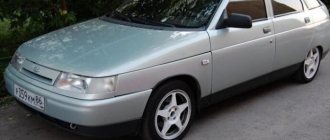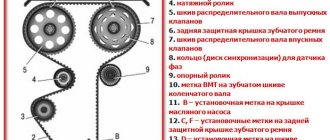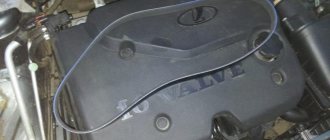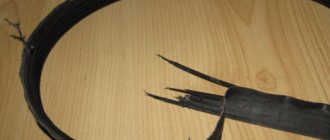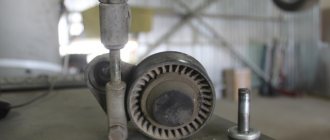Generator drive device
The main condition for the correct functioning of the generator is the correct transmission of rotation from the power plant. To generate the required amount of electricity, the element must rotate at high speed.
The alternator drive belt must be tensioned for proper transmission. If the belt sag, it will begin to slip on the pulleys. If the belt is overtightened, there is a risk of premature wear of the bearings, working surfaces of the pulley and belt.
To avoid these troubles, belt tension adjustment was included in the design.
In modern cars the number of attachments is large. This equipment is also driven by the crankshaft pulley, including the power steering pump and air conditioning compressor.
The drive of these two units and the generator is carried out using a single belt. Because of this, it is impossible to adjust the tension of the drive element using a generator. Such cars have a complex belt position configuration. Belt-driven equipment is located at different levels.
How to change the alternator belt tensioner pulley? To do this, you need to understand its structure. The generator belt tensioner roller is a bearing with a plastic lining on its outer race. The pad has a working surface along which the belt moves. There is a landing sleeve inside the roller. There are two types of rollers:
- Eccentric . The design of this video is quite simple. It contains only a bearing, a plastic lining and a bushing. A through hole passes through the bushing, offset away from the center of the roller. The roller is put on a pin through the hole, which is installed on the engine. To tighten, the roller must be rotated relative to the bolt.
- Roller with bracket . In this design, the roller is fixedly mounted on a bracket. The structure is attached to the power plant using bolts. Moving the bracket relative to the engine adjusts the tension. Manufacturers sometimes use rollers with a spring bracket. The spring allows you to independently adjust the tension.
The bearing is the main weak point of the roller. This part is forced to constantly experience loads. Wear of a part sometimes even ends in its complete breakdown.
It is recommended to change the bearing every time the belt is replaced.
The importance of tension level and checking it
How to tension the alternator belt
Let's consider what unpleasant consequences an incorrect level of tension will lead to. If it is weakened, then there is a high probability of slippage . That is, the generator drive will not operate at rated speed, which in turn will lead to the level of voltage generated by it being below normal. The result is an insufficient level of battery charging, insufficient electricity to power the vehicle systems, and operation of the electrical system under increased load. In addition, when slipping, the temperature of the belt itself increases significantly, that is, it overheats, which is why it loses its service life and may fail prematurely .
If the belt is too tight, this can also lead to excessive wear on the belt itself . And in the worst case, even to its breakage. Also, excessive tension has a detrimental effect on the bearings of the crankshaft and generator shaft, because they have to work under conditions of increased mechanical load. This leads to excessive wear and speeds up their failure.
Signs of a faulty alternator belt tension roller
First, make sure that the alternator belt tensioner pulley needs to be replaced. Signs of its malfunction are listed below:
- the generator does not fully charge the on-board network or it does not receive electricity at all;
- from the side where the belt is located, a sound similar to squeaking is heard;
- a hum is heard;
- the roller or belt vibrates a lot when the power plant is running;
- there is play in the video;
- The belt is worn on one side.
Some of these symptoms may indicate a problem with the components that drive the roller. A hum and squeaking noise may indicate wear on the bearings of the power steering pump, air conditioner or compressor. The malfunction may lie in the generator itself.
Where is the timing belt located?
First, let's remember where the timing belt is located and what it looks like. Its location is in front of the engine, but do not forget that motors come in longitudinal and transverse locations. In most cases, gas distribution mechanisms use a toothed rubber belt, but in a considerable number of car models from different manufacturers, a steel chain is also used for this.
Engine cylinders can be equipped with two or four valves with one and two camshafts (CV), respectively. The kinematics of the gas distribution mechanisms of such engines differ. We will show them using the example of 8- and 16-valve power units for the VAZ 2110, 2111 and 2112.
The scheme with two shafts is more complicated, and in it, in addition to the pulley of the second RV, a support roller is added. This also complicates the belt replacement procedure. It is most difficult to perform this operation after a break or severe stretching of the belt, when the factory timing settings can be completely lost. Replacing in normal mode is not so difficult that you can’t try to do it yourself.
Diagnostics of the drive belt tensioner
The drive belt tensioner must be checked for serviceability when at least one of the above symptoms appears. Other structural elements also need diagnostics. Diagnostics is performed in several stages:
- It is necessary to visually familiarize yourself with the belt and the equipment driven by it. To do this, start the power plant and check whether there are vibrations of the belt, pulley or roller.
- Check the tension of the alternator belt. To do this, stop the engine. Next, on the largest span between the pulleys, take the belt and try to turn it clockwise. If you can turn it 90 degrees, then its tension is fine. Otherwise, the rotation angle will be smaller or larger, and then adjustment will be required.
- The next step is to remove the belt and check its condition. It is also necessary to check the pulleys and rollers for play. Removing the belt is quite simple. To do this, you must loosen the tension pulley nut. After this, it must be removed from the pulleys. Before doing this, remember the position of the belt between the pulleys, because you will then have to put it back on. It is recommended to take a photo of the position with a mobile phone camera. After removal, check that there are no cracks or peeling on the belt. Belt wear should be even. If any of these defects are detected, feel free to change the belt. Note wear on one side. When such wear occurs, the roller mounting stud or bracket becomes bent, causing misalignment. If this misalignment is not corrected, the belt will not last long.
- The play on the pulleys is checked. Rotate the roller and make sure that there are no jams or jams. If they are present, there will be severe wear of the bearing, and the generator belt tension roller will need to be replaced. Also carefully inspect the working surface of the plastic pad: there should be no grooves on it. If the surface is uneven, the drive belt tension roller must be replaced.
- If after replacing the belt the hum and squeaking does not disappear, then the problem must be looked for in other elements. The drive of these elements occurs due to belt tension.
Mobile operator
SIM card from Yota with unlimited Internet for tablets
The first launch of the first 4G network in Russia, authorized by the Ministry of Communications of Russia, took place by the owners of the Yota brand at the beginning of 2012 in the city of Novosibirsk.
As of March 2015, 4G networks have been launched into commercial operation in 39 regions of Russia. 4G is expected to launch in other cities. As of the end of 2014, Yota’s subscriber base was 1.2 million users.
Providers
Shareholders of MegaFon OJSC and Scartel LLC (Yota brand) announced a merger of assets, their press service reported. As a result of the agreements reached by the shareholders, the holding company Garsdale was created, combining 100% of the shares of Scartel and more than 50% of the shares of OAO MegaFon.
Launch history
In 2006, co-owner of St. Petersburg Denis Sverdlov and entrepreneur Sergei Adonyev decided to create the first operator in Russia operating on the basis of the then new data transmission technology - WiMAX. The name of the company was invented during an SMS correspondence: “What if Yota?” In the fall of 2008, Scartel was the first in Russia to deploy WiMAX networks in Moscow and St. Petersburg in the range of 2.5-2.7 GHz.
In 2010, Yota announced plans to switch from WiMAX technology to a new data transmission technology - LTE, and on August 30, 2010, a test launch of the first network of the new communication standard in Russia took place. Yota was the contractor for the construction of the WiMAX network and the subsequent transition to LTE. As of August 2015, Yota users are provided with Internet using LTE technology in 48 regions of Russia.
From April 2014 to April 2015, the general director of Scartel LLC was Anatoly Smorgonsky. His place was taken by Mikhail Dubin, executive director for business development in the mass market. In August 2015, Dubin left both positions, and Konstantin Likhodedov was appointed new general director of Scartel (and executive director of MegaFon).
In November 2016, Vladimir Dobrynin was appointed to the position of General Director of Scartel LLC.
Detailed chronology
- 2007, May - founding of the company.
- 2008, September 2 - official launch of test operation of WiMAX networks at a frequency of 2.5-2.7 GHz in Moscow, St. Petersburg and Ufa under the Yota brand.
- 2008, October 2 - the start of sales of the world's first phone with WiMAX support, HTC MAX 4G, made by HTC by order of Yota specifically for Russia.
- 2008, December 25 - start of sales of WiMAX Express cards for connecting to Yota.
- 2009, March 23 - sales of the first WiMAX laptop in Russia began.
- 2009, June 1 - start of commercial operation for individuals.
- 2009, August 18 - Yota's subscriber base exceeded 100,000 people.
- 2009, October 7 - start of sales of Yota Egg devices.
- 2009, October 12 - subscriber base - more than 150,000 people.
- 2009, December 3 - subscriber base - more than 250,000 people.
- 2009, December 16 - Yota begins testing the network abroad in Russia, in Managua (Nicaragua).
- 2010, August 30 - launch of Russia's first LTE network in Kazan.
- 2010, December 5 - The First International Yota Space Festival started.
- 2011, December 1 - official launch of the Yota network in Belarus.
- 2011, March 3 - Yota, in the presence of Russian Prime Minister Vladimir Putin, signed an agreement with telecom operators VimpelCom, Megafon, MTS and Rostelecom on the development of the LTE network in Russia.
- 2011, June 6 - Yota One and Yota Many went on sale.
- 2012, June 11 - Yota ceases providing services in Belarus.
- 2012, July - reorganization was completed in the form of the merger of Scartel LLC (Yota brand) with MegaFon PJSC.
- 2012, October 9 — Yota was the first in Russia to launch LTE-Advanced mobile communication technology on a commercial network in Moscow. 11 base stations are participating in the launch [ source not specified 425 days
]. - 2014 April 23 - the commercial launch of a new federal cellular operator in Russia - the Yota operator - was announced.
- 2014, August 13 - start of issuing pre-ordered SIM cards of the virtual cellular operator "Yota".
- 2017, January 25 - tariffs with unlimited Internet for smartphones are closed for connection. Introduction of a new tariff line for smartphones with limited traffic.
Cooperation between MegaFon PJSC and Scartel LLC
In April 2014, the emergence of a new federal cellular operator Yota was announced based on the combined network of MegaFon and Scartel. In fact, we are talking about the emergence of another “niche” virtual operator. In August 2014, the issuance of Yota SIM cards to users who pre-ordered started in six cities: Moscow, St. Petersburg, Vladivostok, Khabarovsk, Vladimir and Tula. By the end of 2014, the coverage area had grown to 28 cities, and as of August 2015, the cellular operator Yota issues SIM cards in 52 regions of Russia. The combined network of Megafon and Scartel includes broadcasting only on the 2600 MHz band (Band 7), so in cities where their own LTE networks were built at 800 MHz (Band 20), for example, in Tolyatti or Syzran, Yota It is not possible to provide 4G communication services due to lack of coverage.
As a cellular operator, Yota provides its customers with federal coverage in 2G / 3G / 4G networks, free calls within the Yota network, federal mobile numbers in +7 and 8 formats, as well as a single cost for services within the Russian Federation and coverage areas bordering Russia territories. It is possible to switch to a Yota SIM card while maintaining the old phone number.
In addition, Yota has released a multi-format SIM card that includes NFC and electronic digital signature modules.
In October 2014, the product line of the mobile operator Yota expanded with SIM cards for tablets, allowing customers to independently choose the required speed of unlimited network access, which determines the size of the subscription fee.
Since July 2015, Yota began providing mobile communication services in the Arkhangelsk, Samara, Nizhny Novgorod, Pskov, Novgorod, Tyumen regions, Kalmykia, Mordovia, Udmurtia, and Altai Territory. In August 2015, Yota appeared in the Sverdlovsk, Chelyabinsk, Kaliningrad, Volgograd regions, Perm Territory, Khanty-Mansi Autonomous Okrug, Altai Republic, Dagestan, Chechnya. In September 2015, the issuance of SIM cards started in the Saratov, Belgorod, Kirov, Murmansk, Ivanovo, Tver, Smolensk regions and Stavropol Territory. In October 2015, Yota began providing communication services in the Amur region, Buryatia, Jewish Autonomous Region, Trans-Baikal Territory, Yakutia, and in November 2015 - in the Rostov and Ryazan regions. Since January 2016, you can connect to the Yota mobile operator in the Republic of Ingushetia, Adygea, Kabardino-Balkaria, North Ossetia and the Voronezh region, from February 2016 - in Karachay-Cherkessia, from July 2016 - in the Sakhalin region, from August 2016 - in Komi and Yamal-Nenets Autonomous Okrug, since October 2016 - in the Kurgan region.
On January 25, 2022, tariffs with unlimited Internet are closed for connection. A new tariff line with limited traffic was introduced; the new tariffs have no restrictions on Internet distribution. The company offers the “Unlimited mobile applications” option, where traffic is not spent on some social networks and instant messengers. Subscribers who connected before January 25, 2022 will remain on tariffs with unlimited Internet. [ significance of the fact?
]
Yota and Yota Devices
The division of the companies did not take place in an atmosphere of secrecy, but was not widely covered in the media. This was the first and main reason that many - both users and representatives of the telecom market - still consider Yota and Yota Devices to be one company. [ source not specified 388 days
]
Initially, Yota and Yota Devices were indeed one company. More precisely, the latter were a department within Yota and were engaged in the development of user devices - modems and routers. In 2011, Yota Devices left Big Brother, became a separate company and began developing its own smartphone.
Logo
The company's logo shows an upside-down man, made in a minimalist style, called “Nuf”, or “Nuf”: if you read this word backwards - “Fun” (from English - “fun”).
How to change the alternator belt tensioner pulley?
As an example, consider the Chevrolet Lacetti. This car is quite popular in Russia. It can be found on many trading platforms. In addition, this car has a typical design compared to other cars. The Chevrolet Lacetti is equipped with a self-adjusting tension roller with a bracket.
To replace the roller, you will need the following set of tools: a set of open-end wrenches and sockets with gates. The installation sequence is presented below:
- The air filter housing is removed from the engine. This is done to provide access to the belt.
- The power steering pump is unscrewed. After this you can get to the video itself. To get to its mounting bolts, it is necessary to remove the exhaust manifold protective screen from the engine.
- After the screen has been removed, the power steering pump bolts are unscrewed. The pump moves to the side to provide access to the roller. After unscrewing, you can remove the belt from its pulley. The pipes going to the pump do not need to be removed.
- Before unscrewing the roller, it must be brought into the mounting position. To do this, the roller moves, overcoming the force of the spring before the locking holes on the bracket body are aligned. Next, the roller is locked in the same position using a bolt or splitter installed in the hole.
- The bolts securing the bracket and roller are unscrewed. The roller is removed. The new element also needs to be moved into its installation position. After this, it is installed in the structure and secured with bolts.
- The power steering pump together with the protective screen are secured and installed in place. The belt is put on the pulleys. To do this, use a photo with the correct position of the belt.
- The locking bolt or cotter pin is removed. This is done so that the spring produces the necessary belt tension.
On other models, replacing the alternator belt tensioner pulley may be slightly different. Most often, on cars with eccentric rollers, tensioning is carried out using a special key. With this wrench, the roller is rotated around the pin for tension purposes.
Causes of toothed belt wear on VAZ 8 valve engines
- Wear of the timing belt on the front side is the main cause of a worn pump, but sometimes it can also be the tension roller stud and, in very rare cases, the camshaft sprocket. To eliminate this problem, replace the worn part.
- Wear on the rear side is much less common. The main reason is the bolt on the oil pump. Over time, the belt tension weakens a little and, vibrating, it begins to reach this bolt. It’s very easy to fix this problem; we replace the Torx sprocket bolt with a regular 10mm socket, its head is smaller and the timing belt is no longer missing. The photo shows wear from the belt.
conclusions
The generator belt tension roller is an important part, without which the correct functioning of the generator is impossible. At the slightest sign of severe wear, it is necessary to replace the generator belt tension roller. The roller can be found at a parts store. It is also necessary to monitor the remaining elements of the generator design. Replacing the tension roller of the alternator belt should not cause difficulties and can easily be carried out by the car owner himself without contacting a service station. Good luck and easy travels!
Source: auto-gl.ru
We will add only one thing on our own - do not neglect the advice of this article, and seek the service of replacing a spare part or repairing a car only at certified service stations or official dealers, because a malfunction of this part of the car can cause quite a lot of trouble on the road, and consequences afterwards, i.e. To. It's not just the alternator that turns the belt.
Preparatory operations
It's immediately obvious that the owner loves his car.
VAZ engine 8 valves.
If you plan to replace the pump, then let the engine cool, remove the protection and then drain the antifreeze. It is enough to drain only from the cylinder block.
Plug on the cylinder block.
Jack up the car and remove the front right wheel and plastic mudguard.
Price of work
| For 2.0 diesel: price 6,000 rubles. For 1.6 gasoline: price 3500 rubles. Includes replacement of belt, rollers, pump. For 1.4 TSI: 6000 rub. Computer diagnostics of the car FREE OF CHARGE Warranty 1 year or 20,000 km. |
Spare parts
Spare parts can be purchased by number at any auto store. A list of required parts with numbers is given below. If necessary, I will send a list according to the VIN of the car. Timing belt replacement kit for 2.0 TDI, 1.6 BSE, 1.4 TSI engines available.
